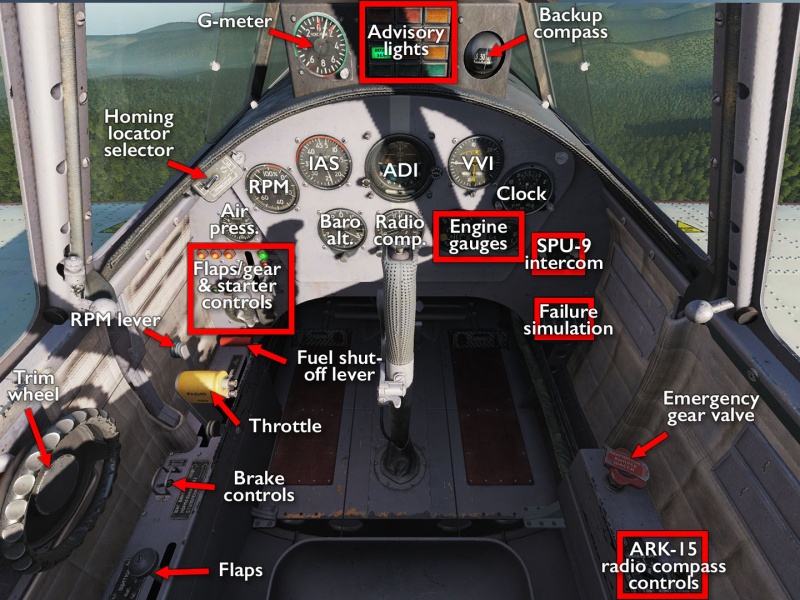Yak-52: Difference between revisions
m (→�) |
m (→�) |
||
| Line 24: | Line 24: | ||
* There are numerous missing or non-functional keybinds. | * There are numerous missing or non-functional keybinds. | ||
* The manual is lacking in describing what few systems and instruments are actually available. | * The manual is lacking in describing what few systems and instruments are actually available. | ||
* Basic functions like wheel chucks, radio, and navigation instruments are still work in progress, and the .published procedures include steps that involve these non-functional systems. | |||
The latter two in particular means that a literal reading of the manual can sometimes lead to situations where “proper procedures” will outright destroy the aircraft. A bit of common sense will work around that, but until the module is complete, some flexibility on the pilot's part is a definite requirement | |||
== Flying the Yak-52 == | == Flying the Yak-52 == | ||
Revision as of 15:47, 12 August 2018
| This is an alpha module.
This module is still being developed and is missing central features and equipment options. While it is playable, it may have major bugs, and procedures may have inconsistent or unexpected results. The intrepid and very interested may want to buy it; others should probably wait for a more stable or complete release. |
The Як-52 is a 1970:s Soviet trainer aircraft for volunteer “sport pilots” that could serve as a reserve for civilian and military air services. It also took on, and remains in, the role of an easy-to-fly agile aerobatics aircraft. In the context of DCS World, it serves almost as an even earlier step than the L-39 in the progression of learning how to fly, and shares many of the Albatros' features.
From a more technical standpoint, the Yak-52 is Eagle Dynamics' testbed for simulating radial-engine prop planes, which would provide them with a broader foundation to build future aircraft. Since they do a fair amount of commission work, this would allow them to attract new clients, and getting a DCS module out of it is just a bonus.
Features
Even more so than the L-39C, the Yak-52 is a trainer aircraft, and this is readily apparent in the feature list. At the same time, aside from that small detail, the overlapping relationship and role progression between the two aircraft is also readily apparent:
- No weapons of any kind — this is all about the flying.
- A simple VHF radio and NDB-based radio navigation.
- A proper tricycle landing gear (this is a big deal compared to earlier DCS prop planes)
- Differential braking rather than nose-wheel steering.
- Multicrew — act as a proper
back-seat driverinstructor to your poor trainee friend in the front seat. - A manual that features more chapters on proper flying technique and common pilot errors than any other topic.
Missing features
The Yak-52 is still early in its development cycle and is marked early access in the DCS store for good reason. Nothing is likely to break or explode unexpectedly, and with few on-board systems, there is little that even can be considered missing as long as the thing flies. Nevertheless, there are some obvious gaps in the simulation at this point:
- Flight dynamics and mechanical performance still need a lot of tweaking.
- There are numerous missing or non-functional keybinds.
- The manual is lacking in describing what few systems and instruments are actually available.
- Basic functions like wheel chucks, radio, and navigation instruments are still work in progress, and the .published procedures include steps that involve these non-functional systems.
The latter two in particular means that a literal reading of the manual can sometimes lead to situations where “proper procedures” will outright destroy the aircraft. A bit of common sense will work around that, but until the module is complete, some flexibility on the pilot's part is a definite requirement
Flying the Yak-52
While it is a propeller aircraft, the Yak-52 should not be confused with the WWII prop planes previously featured in DCS. This is an aircraft built almost half a century later, meant to teach flying rather than to be a temperamental high-performance combat airplane. You still have to manage cooling valves, RPM, throttle settings, and keep an eye on manifold pressures like in the olden days, but it is all much more “set it and forget it” than in the fighter planes.
In short, the Yak-52 is very easy and forgiving to fly. It only has elevator trim, but does not need much more, and it will happily and snappily respond to the pilot's inputs. While it will stall if you get down to double-digit speeds, it is actually somewhat difficult to make it depart from controlled flight. It will happily do anything between -5(!) – +7 G without inducing an undesired slips, rolls or spins , and the pilot is more likely to come apart before the airframe does during any more extreme manoeuvres.
Cockpit overview
Getting into the air
Links and files
- DCS: Yak-52 in the DCS shop.
More information
- Yakovlev Yak-52 on wikpedia.
- Yak-52 on globalsecurity.org





